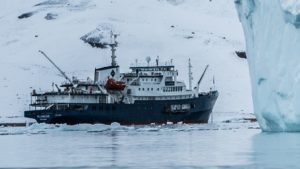Ships constructed on or after 1 January 2017 shall comply with the safety part of Polar Code at delivery. Ships constructed before 1 January 2017 shall comply with the safety part of the Polar Code by the first intermediate or renewal survey, whichever occurs first, after 1 January 2018. Only ships that intend to operate within the Arctic and Antarctic waters as defined in the Polar Code need to comply with the code.
The Code will require ships intending to operate in the defined Arctic and Antarctic waters to apply for a Polar Ship Certificate, which would classify the vessel as either:
Category A – ships designed for operation in polar waters in at least medium first-year ice, which may include old ice inclusions
Category B – a ship not included in category A, designed for operation in polar waters in at least thin first-year ice, which may include old ice inclusions
Category C – a ship designed to operate in open water or in ice conditions less severe than those included in categories A and B.
The Polar Code consists of Introduction, parts I and II. The Introduction contains mandatory provisions applicable to both parts I and II. Part I is subdivided into part I-A, which contains mandatory provisions on safety measures, and part I-B containing recommendations on safety. Part II is subdivided into part II-A, which contains mandatory provisions on pollution prevention, and part II-B containing recommendations on pollution prevention.

Ships operating in the Polar Regions face a number of unique risks such as: ice, low temperature, extended periods of darkness or daylight, high latitude, lack of accurate and complete hydrographic data and information, rapidly changing and severe weather conditions, etc.
The Polar Code sets out mandatory standards and functional requirements that apply to ships operating in the Arctic and Antarctic areas and covers ship structure, stability and subdivision, watertight and weathertight integrity, machinery installations, fire safety/protection, life-saving appliances and arrangements, safety of navigation, communications, voyage planning, manning and training, prevention of pollution by oil, control of pollution by noxious liquid substances in bulk, prevention of pollution by harmful substances carried by sea in packaged form, prevention of pollution by sewage from ships, and prevention of pollution by garbage from ships.
Masters, Chief Mates and Officers in charge of a navigational watch should be qualified and certified in accordance with regulation II/2 of the STCW Convention and section A-II/2 of the STCW Code. In addition, they should meet the advance training requirements noted in the paragraph 12.3.
A detailed gap analysis is required and the following documents and manuals (but not limited to) should be revised and be prepared:
– Operational assessment report with hazards (Hazard analysis) of the intended operations based on the sources of hazards listed in the Code.
– Polar Water Operational Manual. The PWOM shall address the challenges found in the Hazard Analysis and document the practical operation of the ship in polar waters.
-Documentation of systems and equipment installed or to be installed in order to comply with the Polar Code and that this is fully functional at the established polar service temperature (PST) for the vessel.
-Intact stability calculations that include allowance for icing according to the Polar Code Reg. 4.3.
-Other design drawings such as Hull drawings/scantlings and scantlings of propeller blades, etc.
– Garbage Record Book, Cargo Record Book, Oil Record Books, etc.
-Various manuals such as Garbage Management Plan, Shipboard Marine Pollution Emergency Plan, Clean Ballast Tank Operations, Discharge of Noxious Liquid Substance, etc.
Source: MEPC.265(68)
Contact us to conduct a detailed gap analysis &
to receive a professional advisory in your area of interest.
